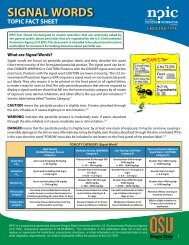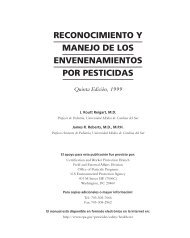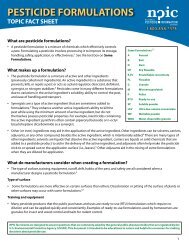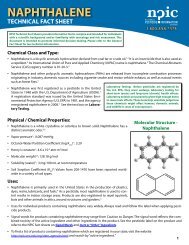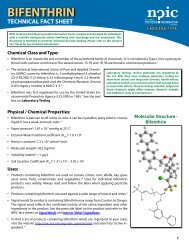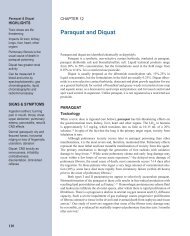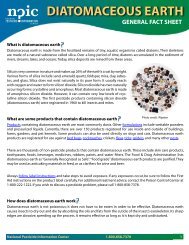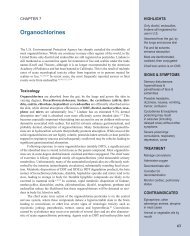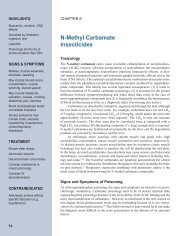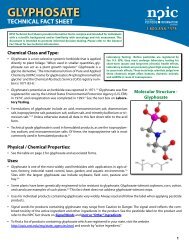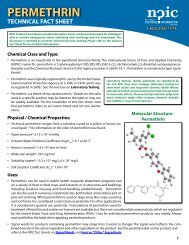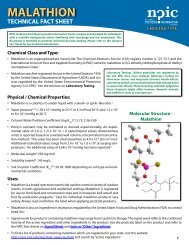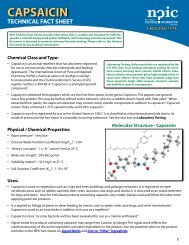Bendiocarb Technical Fact Sheet - National Pesticide Information ...
Bendiocarb Technical Fact Sheet - National Pesticide Information ...
Bendiocarb Technical Fact Sheet - National Pesticide Information ...
Create successful ePaper yourself
Turn your PDF publications into a flip-book with our unique Google optimized e-Paper software.
This fact sheet was created in 2002; some of the information may be out-of-date.<br />
NPIC is not planning to update this fact sheet. More pesticide fact sheets are<br />
available here. Please call NPIC with any questions you have about pesticides at<br />
800-858-7378, Monday through Friday, 8:00 am to 12:00 pm PST.<br />
NPIC <strong>Technical</strong> <strong>Fact</strong> <strong>Sheet</strong>s are designed to provide information that is technical in nature for<br />
individuals with a scientific background or familiarity with the regulation of pesticides by the U.S.<br />
Environmental Protection Agency (U.S. EPA). This document is intended to be helpful to professionals<br />
and to the general public for making decisions about pesticides.<br />
<strong>Bendiocarb</strong><br />
(<strong>Technical</strong> <strong>Fact</strong> <strong>Sheet</strong>)<br />
For less technical information, please refer to the General <strong>Fact</strong> <strong>Sheet</strong>.<br />
The <strong>Pesticide</strong> Label: Labels provide directions for the proper use of a pesticide product. Be sure to read the entire label before<br />
using any product. Signal words, listed below, are found on the front of each product label and indicate the product’s potential<br />
hazard.<br />
CAUTION - low toxicity WARNING - moderate toxicity DANGER - high toxicity<br />
What is bendiocarb<br />
∙ <strong>Bendiocarb</strong> belongs to a class of insecticides (chemicals that kill or control insects) known as carbamates (1).<br />
∙ <strong>Technical</strong> grade bendiocarb is an odorless, non-corrosive white crystalline solid (2).<br />
∙<br />
<strong>Bendiocarb</strong> was first registered in the United States in 1980. Its registration was voluntarily canceled in September<br />
1999, and all products containing bendiocarb lost registration in December 2001. Products with canceled registrations<br />
cannot be purchased after that date, but existing stocks can still be used according to labeled directions (1).<br />
How is bendiocarb used<br />
$ <strong>Bendiocarb</strong> products are used in gardens, turf, soil, and<br />
ornamental plants as granular, dust, or liquid spray<br />
formulations.<br />
$ In and around the home, products with bendiocarb are<br />
formulated as dusts and sprays for spiders, wasps, ants, flies,<br />
and stored product pests.<br />
$ <strong>Bendiocarb</strong> products can also be registered for use in hotels,<br />
restaurants, warehouses, hospitals, railroad boxcars and<br />
aircraft.<br />
Laboratory Testing: Before pesticides are registered<br />
by the U.S. EPA, they must undergo laboratory testing<br />
for short-term (acute) and long-term (chronic) health<br />
effects. Laboratory animals are purposely fed high<br />
enough doses to cause toxic effects. These tests help<br />
scientists judge how these chemicals might affect<br />
humans, domestic animals, and wildlife in cases of<br />
overexposure. When pesticide products are used<br />
according to the label directions, toxic effects are not<br />
likely to occur because the amount of pesticide that<br />
people and pets may be exposed to is low compared<br />
to the doses fed to laboratory animals.<br />
What are some products that contain bendiocarb<br />
$ Ficam<br />
$ Turcam<br />
$ Tattoo<br />
$ Multamat
What is the mechanism of action for bendiocarb<br />
$ <strong>Bendiocarb</strong> disrupts the normal functioning of an insects nervous<br />
system and may cause toxicity by either contact or ingestion (3).<br />
$ The chemical neurotransmitter acetylcholine is released to relay<br />
nervous system signals across the nerve synapse.<br />
Acetylcholinesterase is the enzyme responsible for breaking<br />
down this neurotransmitter once it is released into the synapse<br />
and is necessary for proper nerve function. When the enzyme is<br />
inhibited, acetylcholine accumulates, resulting in nervous system<br />
overstimulation (4).<br />
$ <strong>Bendiocarb</strong> disrupts the nervous system by adding a carbamyl<br />
moiety to the active site of the acetylcholinesterase enzyme.<br />
This prevents acetylcholine from reaching the active site and<br />
renders the enzyme inactive. However, the carbamyl group is<br />
released by spontaneous hydrolysis, thus reversing the disruption<br />
and restoring activity (5, 6).<br />
LD50/LC50: A common measure of acute toxicity<br />
is the lethal dose (LD50) or lethal concentration<br />
(LC50) that causes death (resulting from a single<br />
or limited exposure) in 50 percent of the treated<br />
animals. LD50 is generally expressed as the dose<br />
in milligrams (mg) of chemical per kilogram (kg) of<br />
body weight. LC50 is often expressed as mg of<br />
chemical per volume (e.g., liter (l)) of medium (i.e.,<br />
air or water) the organism is exposed to.<br />
Chemicals are considered highly toxic when the<br />
LD50/LC50 is small and practically non-toxic when<br />
the value is large. However, the LD50/LC50 does<br />
not reflect any effects from long-term exposure<br />
(i.e., cancer, birth defects, or reproductive toxicity)<br />
that may occur at levels below those that cause<br />
death.<br />
What is the acute toxicity of bendiocarb<br />
Oral<br />
<strong>Bendiocarb</strong> is moderately to highly toxic to both male<br />
and female rats when ingested. The oral LD50 in male<br />
and female rats ranges from 34 mg/kg to 156 mg/kg<br />
(7). See boxes on Laboratory Testing, LD50, and<br />
Toxicity Category.<br />
Ingested bendiocarb is highly toxic to guinea pigs. The<br />
acute oral LD50 in guinea pigs is 35 mg/kg (7).<br />
<strong>Bendiocarb</strong> is also highly toxic to rabbits by ingestion.<br />
The acute oral LD50 in rabbits ranges from 35-40<br />
mg/kg (7).<br />
In one test, female beagles were given high doses<br />
orally and recovered in 24-25 hours with no sideeffects<br />
(7).<br />
Toxicity Category<br />
Dermal<br />
<strong>Bendiocarb</strong> applied to the skin of rats is moderately toxic. The dermal LD50 ranges from 566 to 800 mg/kg for male<br />
and female rats (7).<br />
Signs of Toxicity - Animals<br />
Signs of bendiocarb poisoning may include behavioral changes, excessive tearing and salivation, muscle tremors,<br />
twitching, vomiting, and diarrhea. Severe intoxications can result in paralysis and death (6).<br />
Cats are typically more sensitive to the effects of bendiocarb than dogs (6).<br />
High<br />
Toxicity<br />
(Danger)<br />
Moderate<br />
Toxicity<br />
(Warning)<br />
Low<br />
Toxicity<br />
(Caution)<br />
U.S. Environmental Protection Agency, Office of <strong>Pesticide</strong> Programs, Label Review<br />
Manual, Chapter 7: Precautionary Labeling<br />
http://www.epa.gov/oppfead1/labeling/lrm/chap-07.pdf (17).<br />
Signs of Toxicity - Humans<br />
Early symptoms associated with bendiocarb exposure may include headache, malaise, muscle weakness, nausea,<br />
gastrointestinal cramps, sweating, and restlessness (4, 5).<br />
Oral<br />
LD50<br />
Dermal<br />
LD50<br />
Inhalation<br />
LC50 - 4hr<br />
Eye<br />
Effects<br />
Skin<br />
Effects<br />
Less than 50<br />
mg/kg<br />
Less than 200<br />
mg/kg<br />
Less than 0.05<br />
mg/l<br />
Corrosive<br />
Corrosive<br />
50 - 500<br />
mg/kg<br />
200 - 2000<br />
mg/kg<br />
0.05 - 0.5<br />
mg/l<br />
Irritation<br />
persisting for<br />
7 days<br />
Severe<br />
irritation at<br />
72 hours<br />
500 - 5000<br />
mg/kg<br />
2000 - 5000<br />
mg/kg<br />
Very Low<br />
Toxicity<br />
(Caution)<br />
Greater than<br />
5000 mg/kg<br />
Greater than<br />
5000 mg/kg<br />
0.5 - 2 mg/l Greater than<br />
2 mg/l<br />
Irritation<br />
reversible<br />
within 7 days<br />
Moderate<br />
irritation at<br />
72 hours<br />
Minimal<br />
effects, gone<br />
within 24 hrs<br />
Mild or slight<br />
irritation
<strong>Bendiocarb</strong> intoxication may lead to pin-point pupils, tearing, excessive salivation, nasal discharge, vomiting,<br />
diarrhea, muscle twitching, and ataxia. Severe poisonings can result in convulsions, CNS depression, coma, and death<br />
(4, 5).<br />
The red blood cell cholinesterase test may be able to document an acute bendiocarb poisoning if administered<br />
immediately after exposure, but it may be misleading due to the rapid regeneration of the affected enzyme. Also,<br />
urine can be analyzed for unique breakdown products of bendiocarb to assess exposure (5).<br />
Is bendiocarb a carcinogen<br />
Animals<br />
Mice fed diets containing either 50, 250, or 1250 ppm<br />
bendiocarb did not show any significant increases in<br />
tumors over the control animals (7). See Cancer box.<br />
Rats fed diets containing 2, 20, or 200 ppm bendiocarb for<br />
104 weeks showed a dose-dependent increase in<br />
lymphoreticular tumors. Only the highest dose produced a<br />
statistically significant effect (7).<br />
Cancer: The U.S. EPA has strict guidelines that require<br />
testing of pesticides for their potential to cause cancer.<br />
These studies involve feeding laboratory animals large<br />
daily doses of the pesticide over most of the lifetime of<br />
the animal. Based on these tests, and any other<br />
available information, EPA gives the pesticide a rating<br />
for its potential to cause cancer in humans. For example,<br />
if a pesticide does not cause cancer in animal tests, then<br />
the EPA considers it unlikely the pesticide will cause<br />
cancer in humans. Testing for cancer is not done on<br />
human subjects.<br />
Humans<br />
Researchers have found bendiocarb does not increase the risk of cancer in humans. The EPA has categorized<br />
bendiocarb as a Group E carcinogen, indicating evidence of non-carcinogenicity for humans (1).<br />
Does bendiocarb cause reproductive or teratogenic effects<br />
Animals<br />
Rabbits exposed to 2.5 and 5 mg/kg bendiocarb in utero<br />
throughout days 6-28 of gestation showed a dose dependent<br />
increase in eye abnormalities and undeveloped pubic bones<br />
(7).<br />
In another experiment with rats, researchers administered<br />
0.25, 1, and 4 mg/kg bendiocarb during days 6-15 of gestation<br />
and found no significant differences existed between offspring<br />
of control rats and treated rats (7).<br />
Exposure: Effects of bendiocarb on human health and<br />
the environment depend on how much bendiocarb is<br />
present and the length and frequency of exposure.<br />
Effects also depend on the health of a person and/or<br />
certain environmental factors.<br />
Reduced survival rates or lowered birth weights were observed in 2 of 21 female rats intubated with 4 mg/kg<br />
bendiocarb from days 6-15 of gestation (7).<br />
Humans<br />
$ No human data was found on the reproductive or teratogenic effects of bendiocarb.<br />
What is the fate of bendiocarb in the body<br />
Animals<br />
Mice, rats, rabbits, hamsters, and dogs eliminated 80-95% of an oral bendiocarb dose within 24-48 hours. The<br />
primary route of elimination was in the urine (7).<br />
In a study with rats, 90% of an oral bendiocarb dose was excreted in the urine, 1-3% in expired air, and 3-8% in the<br />
feces. Excretion was complete within 24 hours (8).
Male and female rats were fed bendiocarb at two doses and monitored for residue accumulation. The chemicals did<br />
not partition into any one tissue to a greater extent than another and all tissue residues were very low (8). Other<br />
studies agree with this, finding no sign of accumulation in mammals (7).<br />
The primary metabolite in rat urine is the conjugated phenol, 2,2-dimethyl -1, 3-benzoxodiol-4-ol. This compound is<br />
also referred to as NC 7312 (7, 8, 9).<br />
Humans<br />
A male volunteer ingested 9.8mg bendiocarb and excreted 99.2% in the urine within 22 hours (8).<br />
The primary metabolite excreted in the urine of humans exposed to bendiocarb is the conjugated phenol, NC 7312<br />
(7,8).<br />
What is the environmental fate of bendiocarb<br />
Plants<br />
The half-life of bendiocarb residues on plant foliage ranges from<br />
3 to 18.3 days (9, 10). See Half-life box.<br />
Soil<br />
The half-life of bendiocarb in the soil depends on soil<br />
composition and pH. The half-life can range from 3 to 21 days,<br />
with an average soil half-life of 5 days (11).<br />
Half-life: The time required for half of the<br />
compound to degrade.<br />
1 half-life=50% remaining<br />
2 half-lives=25% remaining<br />
3 half-lives=12% remaining<br />
4 half-lives= 6% remaining<br />
5 half-lives= 3% remaining<br />
The amount of chemical remaining after a half-life<br />
will always depend on the amount of the chemical<br />
present initially.<br />
<strong>Bendiocarb</strong> has a very low potential for movement through the soil to groundwater due to its soil sorption coefficient<br />
of 570 ml/g and low water solubility of 40 mg/l (12).<br />
Does bendiocarb degrade indoors<br />
Researchers who applied a 1% solution of bendiocarb to a vinyl tile floor in a furnished office found that airborne<br />
concentrations peaked during the application at 2.7 µg/m 3 . Concentrations were reduced to 26% of the peak value in<br />
2 hours, 6% after 1 day, and 5% after 2 days (13).<br />
In another study, scientists applied a 0.5% wettable-powder bendiocarb solution to cracks and crevices in furnished<br />
dorm rooms. Airborne concentrations peaked during application at 7.7 µg/m 3 . Airborne levels of bendiocarb<br />
decreased to 1.3 µg/m 3 after one day, and were not detectable on the second or third days (14).<br />
Does bendiocarb affect wildlife<br />
Birds<br />
$ Ingested bendiocarb is moderately to highly toxic to various species of birds. The oral LD50 for mallard ducks is<br />
3.1mg/kg, 19 mg/kg in bobwhite quail, and 137 mg/kg in domestic hens (15).<br />
Fish and Aquatic Life<br />
$ The 96-hour LC50 for fish exposed to bendiocarb is 0.86 mg/l for sheepshead minnows, 1.65 mg/l for bluegill<br />
sunfish, and 1.55 mg/l for rainbow trout, indicating it is moderately to highly toxic (15).<br />
$ <strong>Bendiocarb</strong> is highly toxic to freshwater invertebrates. In Daphnia, it has a 24-hour LC50 of 0.33mg/l and a 48-hour<br />
LC50 of 0.16 mg/l (15).
Terrestrial Invertebrates<br />
$ <strong>Bendiocarb</strong> is highly toxic to honey bees with an oral LD50 of 0.1 µg/bee (1, 15).<br />
$ <strong>Bendiocarb</strong> is extremely toxic to earthworms. In one study, it reduced the earthworm population by more than 90%<br />
when applied at labeled rates (16).<br />
Date Reviewed: 9-25-02<br />
For more information contact: NPIC<br />
Oregon State University, 310 Weniger Hall, Corvallis, Oregon 97331<br />
Phone: 1-800-858-7378 Fax: 1-541-737-0761 Email: npic@ace.orst.edu<br />
NPIC at www.npic.orst.edu EXTOXNET at http://extoxnet.orst.edu/<br />
References<br />
1. U.S. Environmental Protection Agency EPA R.E.D. <strong>Fact</strong>s: <strong>Bendiocarb</strong>. From<br />
http://www.epa.gov/oppsrrd1/REDs/factsheets/0409fact.pdf (accessed Oct. 2001).<br />
2. <strong>Pesticide</strong> Profiles: Toxicity, Environmental Impact, and Fate; Kamrin, M. A., Ed.; CRC/Lewis Publishing: Boca<br />
Raton, FL, 1997; pp 60-63.<br />
3. FAO/WHO <strong>Pesticide</strong> Data <strong>Sheet</strong>- <strong>Bendiocarb</strong>. Data <strong>Sheet</strong>s on <strong>Pesticide</strong>s No. 52. Food and Agriculture Organization<br />
of the United Nations. From http://www.inchem.org/documents/pds/pds/pest52_e.htm (accessed Oct. 2001).<br />
4. Casarett and Doull’s Toxicology: The Basic Science of Poisons, 5 th ed.; Klaasen C. D., Amdur, M. O., Doull, J., Eds.;<br />
McGraw-Hill: New York, 1996; pp 659-663.<br />
5. Riegart, J. R.; Roberts, J. R. Recognition and Management of <strong>Pesticide</strong> Poisonings, 5 th Edition; U.S. Environmental<br />
Protection Agency, Office of <strong>Pesticide</strong> Programs, U.S. Government Printing Office: Washington, DC, 1999; pp 48-<br />
54.<br />
6. Osweiler, Gary D. Toxicology. <strong>National</strong> Veterinary Medical Series. Williams and Wilkins: Media, PA, 1996; pp<br />
231-236.<br />
7. FAO/WHO <strong>Pesticide</strong> Residues in Food- 1982 Evaluations. Data and Recommendations of the JMPR. Document 573.<br />
FAO Plant Production and Protection Paper No. 49. Food and Agriculture Organization of the United Nations, Rome<br />
1983. From http://www.inchem.org/documents/jmpr/jmpmono/v82pr05.htm (accessed Oct. 2001).<br />
8. Challis, I. R.; Adcock, J. W. The Metabolism of the Carbamate Insecticide <strong>Bendiocarb</strong> in the Rat and in Man. Pestic.<br />
Sci. 1981, 12, 638-44.<br />
9. Groundwater Loading Effects of Agricultural Management Systems (GLEAMS); W.G. Knisel, Ed. Version 2.10;<br />
USDA-ARS: Tifton, GA, 1993.<br />
10. Nigg, H. N.; Brady, S. S.; Kelly, I. D. Dissipation of Foliar Dislodgeable Residues of <strong>Bendiocarb</strong> Following<br />
Application to Azaleas. Bull. Environ. Contam. Toxicol. 1992, 48, 416-20.<br />
11. Hornsby, A. G; Wauchope, R. D; and A. E. Herner. <strong>Pesticide</strong> Properties in the Environment; Springer-Verlag: New<br />
York, 1996; pp 52.<br />
12. Vogue, P.; Kerle, E.; Jenkins, J. Oregon State University Extension <strong>Pesticide</strong> Properties Database; Oregon State<br />
University Extension Service: Corvallis, OR, 1994.<br />
13. Currie, K. L.; McDonald, E. C.; Chung, L.; Higgs, A. R. Concentrations of Diazinon, Chlorpyrifos, and <strong>Bendiocarb</strong><br />
after Application in Offices. Am. Ind. Hyg. Assoc. J. 1990, 51(1), 23-7.<br />
14. Wright, C. G.; Leidy, R. B.; Dupree, H. E. Jr. Insecticides in the ambient air of rooms following their application for<br />
control of pests. Bull. Environ. Contam. Toxicol., 1981, 26, 548-53.<br />
15. A World Compendium: The <strong>Pesticide</strong> Manual, 12 th ed.; Tomlin, C. D. S., Ed.; British Crop Protection Council:<br />
Farnham, Surrey, UK, 2000; pp 67-68.<br />
16. Kunkel, B. A.; Held, D. W.; Potter, D. A. Impact of Halofenozide, Imidacloprid, and <strong>Bendiocarb</strong> on Beneficial<br />
Invertebrates and Predatory Activity in Turfgrass. J. Econ. Entom. 1999, 92, 922-30.<br />
17. U.S. Environmental Protection Agency, Office of <strong>Pesticide</strong> Programs, Label Review Manual, Chapter 7:<br />
Precautionary Labeling http://www.epa.gov/oppfod01/labeling/lrm/chap-07.pdf<br />
NPIC is sponsored cooperatively by Oregon State University and the U.S. Environmental Protection Agency. Data presented through NPIC<br />
documents are based on selected authoritative and peer-reviewed literature. The information in this profile does not in any way replace or<br />
supersede the restrictions, precautions, directions or other information on the pesticide label/ing or other regulatory requirements.




